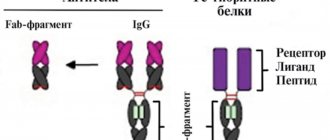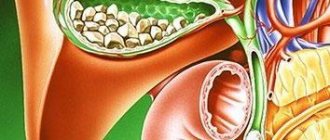Proctitis is an inflammatory disease that is localized in the rectum. First of all, it affects the intestinal mucosa. Very often, proctitis occurs together with sigmoiditis - inflammation of the sigmoid colon (in this case we are talking about proctosigmoiditis).
According to WHO, the risk of developing this disease is observed in 60% of residents of developed countries. Therefore, it is important to remember that early diagnosis plays an important role in the treatment of this disease. Over time, untreated proctitis develops complications and becomes chronic.
At CELT you can get a consultation with a proctologist.
- Initial consultation – 3,000
- Repeated consultation – 2,000
Make an appointment
General information
Proctitis is an inflammation of the rectum of various origins. The rectum is the last section of the intestine, which performs the function of evacuating already digested food. The rectum has an internal/external anal sphincter that contracts to retain feces and relaxes during bowel movements. The intestine ends with the anus (Fig. below).
The rectal wall consists of muscles that control the complex act of defecation, initiated by peristalsis of the sigmoid colon when the maximum volume of feces/gas is achieved by stimulating the receptors of the intestinal wall. The mucous membrane contains many nerve endings that are involved directly in the process of defecation. In addition, the rectal mucosa produces special mucus containing digestive enzymes that promote the process of residual digestion of food, and also acts as a lubricant that facilitates the passage of feces.
The inflammatory process in the rectum can be limited only to the distal part of the rectum or anus, in which the inflammatory process predominantly affects the tissue of the sphincter (obturator orbicularis muscle). This variant is often called "anusitis"/"anitis". In cases of damage to the anal mucosa, the pathological process may involve Morgani's crypts ( cryptitis ) or also the anal papillae ( papillitis ). To a certain extent, inflammation can spread to the sigmoid colon ( proctosigmoiditis ), less often (in 10-30% of cases) to the large intestine with the development of ulcerative necrotizing colitis . Often proctitis is combined with paraproctitis .
There are no exact data on the distribution of isolated colitis. Despite the fact that in general, inflammatory bowel diseases are inferior to other diseases of the digestive system in terms of incidence/prevalence level, but in terms of the frequency of complications, severity and mortality, they occupy one of the leading positions in the world in the structure of gastrointestinal diseases.
What is ulcerative colitis?
Ulcerative colitis is based on a chronic, recurrent inflammatory process that affects the mucous membrane of the large intestine. A feature of the pathology is the formation of numerous deep ulcers on the mucosa in individual segments or along the entire internal surface of the colon (Fig. 1). The location of the lesion determines the course of the disease.
Figure 1. Ulcerative colitis. The photograph shows white ulcers on the intestinal mucosa. Source: selvanegra
The pathological process usually begins in the rectal area, and in 20-30% of cases is limited to it.
In half of the cases, inflammation spreads to the sigmoid, descending colon and transverse colon, and in the rest it covers the entire large intestine. What does the human large intestine consist of?
The large intestine is about two meters long. This is where the final absorption of nutrients from food and the formation of feces occurs. The large intestine is divided into 5 sections: the cecum (it is connected to the ileum of the small intestine) and the appendix, the colon (it is divided into 4 parts - ascending, transverse, descending and sigmoid), rectum and anus, ending in the anus (Fig. .2).
Figure 2. Structure of the large intestine. Source: CC0 Public Domain
Ulcerative colitis most often affects young men under 40 years of age, but the trend in recent years is an increase in the number of cases among children and the elderly. The geographical features of the prevalence of the pathology are interesting: in Australia, the USA and Canada there are 100-150 cases per 100 thousand population, while in Europe this figure does not exceed 15. Residents of African and Asian countries practically do not suffer from ulcerative colitis. In Moscow and the Moscow region, the number of diseases per 100 thousand population is fixed at 22-23 cases per 100 thousand population.
Pathogenesis
Despite the fact that the pathogenesis of proctitis in most cases is based on an inflammatory process, the etiological features of its development determine its specificity, which is not possible to consider within a short article. Therefore, we will consider only the pathogenesis of radiation proctitis , which is based on the activation of the cytokine system in the mucous-submucosal layer of the intestine, which is caused by the massive destruction of tissue cells during the irradiation process. As a result, a cascade of reactions is launched that promotes the development of inflammatory changes in the walls of blood vessels.
Ischemia of the mucous-submucosal lining of the rectum occurs and increases to a critical state with gradually progressive atrophy and fibrosis of the submucosal layer (often with necrotic changes), the end result of which is bleeding from telangiectasias (newly formed vascular plexuses), the formation of recto-vesical / recto-vaginal fistulas and rectal strictures .
What is the danger of ulcerative colitis
Ulcerative colitis is associated with serious complications, some of which can be fatal.
In the worst case, fecal peritonitis develops, i.e. acute inflammation of the peritoneum due to contamination of the abdominal cavity with fecal microflora.
Signs of peritonitis are severe abdominal pain, nausea, vomiting, prolonged constipation, pale skin. It is difficult for the patient to move, his facial features become sharper.
Peritonitis requires urgent surgical intervention. After confirming the diagnosis using ultrasound or fluoroscopy, the abdominal cavity is opened, its sanitation is performed and the defect in the colon wall is sutured.
Important! The success of treating peritonitis directly depends on the time of seeking medical help. If you have severe abdominal pain, you should immediately call an ambulance and do not try to solve the problem with painkillers.
Complications
Other dangerous complications of ulcerative colitis:
- severe bleeding from the colon, development of anemia and shock due to significant blood loss;
- the appearance of malignant neoplasms at the site of ulceration (malignancy);
- damage to the inflamed mucosa by pathogenic intestinal microflora;
- purulent inflammation of nearby tissues.
Most complications of ulcerative colitis can only be treated with surgery. The decision about surgery is made by the attending physician based on a comprehensive examination.
Classification
The classification of proctitis is based on various signs.
According to the duration of the disease/morphological features, inflammation of the rectum is divided into acute and chronic.
Acute proctitis, which in turn, according to characteristic changes in the rectal mucosa, is divided into:
- catarrhal-hemorrhagic (edematous mucosa/presence of hemorrhages);
- catarrhal-purulent (presence of purulent plaque on the mucous membrane);
- polyposis (growth of polyps on the rectal mucosa);
- erosive (there are surface defects on the mucosa).
- ulcerative (ulcers of different sizes form on the mucous membrane);
- ulcerative-necrotic (ulcers and local areas of mucosal necrosis are present on the mucosa).
Chronic proctitis, which is divided according to the condition of the mucous membrane into:
- normotrophic (mucosa without noticeable changes);
- atrophic (folds of the mucous membrane are thinned/smoothed);
- hypertrophic (folds of the mucous membrane are loose and thickened).
According to the etiology, there are nutritional, stagnant (with constipation of various origins), radiation (with radiation therapy), infectious, parasitic, chlamydial, gonorrheal and other proctitis.
Folk remedies
For inflammation of the rectum, remedies from the arsenal of traditional medicine have proven themselves to be effective:
- Sitz baths - pour half a glass of horsetail herb into a liter of boiling water, leave for ten minutes, strain and pour into the bath. Take for thirty minutes.
- Microclysters from a tablespoon of a three percent solution of boric acid and a tablespoon of calendula infusion. The procedure is performed before bed every day.
- Use calendula decoction two tablespoons three times a day. To prepare it, pour two tablespoons of flowers with boiled water and heat for fifteen minutes in a water bath. You can perform microenemas with this product by diluting a teaspoon of infusion in a quarter glass of water.
Causes
Proctitis is a polyetiological disease that develops under the influence of various causes, the main of which include:
- Various types of errors in nutrition (eating disorders, abuse of spicy, salty and spicy foods, smoked foods, fatty foods, alcohol abuse, etc.).
- Mechanical trauma to the rectum (anal intercourse, damage to the rectal mucosa when rough/hard objects are inserted into the anus), rectal surgery for paraproctitis , hemorrhoids / anal fissure .
- Chronic constipation with stagnation of venous blood in the walls of the rectum, which leads to trauma to the mucous membrane and the development of congestive proctitis.
- Damage to the mucous membrane by various irritating substances (enemas with potassium chloride, table salt, iodine, mustard tincture, boric acid). Abuse of enemas, especially when treated with folk remedies, use of too cold/hot solutions.
- Infestation by parasites ( amoebiasis , giardiasis , enterobiasis , ascariasis ), specific infection ( gonorrheal / syphilitic proctitis ).
- Intestinal infections ( dysentery , campylobacteriosis ).
- Inflammatory diseases of the pelvic organs ( prostatitis , vulvovaginitis , cystitis , pouch of Douglas abscess ), non-inflammatory diseases of the rectum of nature ( hemorrhoids ).
- Autoimmune proctitis (with amyloidosis , Crohn's disease , ulcerative colitis ).
- Radiation therapy. Proctitis is caused by excessive intense irradiation, mainly of the pelvic area in patients with oncological pathology ( prostate cancer , / cervical cancer , rectal cancer , etc.).
How are pathologies treated?
Despite the similarity of clinical manifestations, proctitis and paraproctitis are treated differently. Treatment of inflammation of the mucous membrane is conservative. If the inflammatory process affects the intestinal tissue, surgical intervention is required.
Conservative therapy
The goal of therapy is to stop the inflammatory process. For this, the patient is prescribed antibiotics (Ceftriaxone, Medaxone) and antimicrobial agents (Biseptol, Bactrim). To rinse the rectum, enemas are done with Collargol, furatsilin solution or warm chamomile infusion. When the symptoms of inflammation decrease, sitz baths in a weak solution of potassium permanganate and oil microenemas are additionally prescribed.
Treatment of proctitis includes diet. The patient is recommended to exclude fatty, spicy, spicy foods, alcohol, and high-fiber foods from the diet. After recovery, he is advised to consume more dietary fiber along with fruits, vegetables and grains to prevent constipation.
Surgical intervention
Paraproctitis requires emergency surgery. It is carried out immediately after diagnosis using general anesthesia. During this procedure, the abscess is opened, its contents are removed, and the cavity is washed with an antiseptic solution.
To prevent relapse and complications, the operated patient is prescribed a course of antibiotics. Wounds are treated daily with antiseptics or antimicrobial agents. In the postoperative period, it is necessary to follow a diet. It prohibits the consumption of foods that cause gas formation and contain large amounts of fiber, spicy and fatty foods.
If symptoms of proctitis and paraproctitis appear, contact your doctor. An experienced proctologist will see you, make an accurate diagnosis and prescribe effective treatment. If necessary, you will receive emergency care immediately after diagnosis.
Symptoms of proctitis
The symptoms of proctitis are largely determined by its form. In the acute course of proctitis, the symptoms of inflammation of the rectum are significantly pronounced. The disease usually begins suddenly, the patient feels a strong burning sensation in the rectum, a feeling of heaviness/pain in the perineum, aggravated by bowel movements; Tenesmus (false urge) is characteristic.
Diarrhea is observed , in some forms with an admixture of mucus/pus/blood in the stool. The general condition suffers: body temperature rises, chills appear less often.
Catarrhal proctitis
The disease manifests itself as a pain syndrome, which is initially concentrated in the rectal area and intensifies during defecation, and then the pain moves to the perineal area of the scrotum/labia, and in some cases radiates to the back. Patients complain of a frequent urge to defecate, and instead of feces, mucus is released, sometimes with the presence of pus/blood, and the nature of the discharge is directly determined by the form of catarrhal proctitis.
Catarrhal proctitis is accompanied by an increase in temperature to subfebrile/febrile levels. Against the background of fever, symptoms of general intoxication gradually develop: weakness, loss of appetite, headaches, fatigue, and, less often, nausea. Constipation may occur, periodically followed by diarrhea. Acute catarrhal proctitis usually develops over several days. Visual irritation/redness in the anus; upon digital examination, sharp pain and mucus discharge (with pus/blood).
Erosive proctitis
Erosive proctitis is characterized by a sudden onset, false urges, with increased body temperature, chills, pain in the rectum, less often with irradiation to the perineum, lower back, and sacral area. Patients complain of burning, itching and a feeling of heaviness in the anus. Acts of defecation become more frequent, and the stool becomes liquid with the appearance of blood/mucus in the stool. Less commonly, with erosive proctitis, discharge of bloody mucus is noted against the background of tenesmus without fecal impurities. There may be a gaping of the anus with the discharge of liquid feces, mucus/blood.
The severity of clinical symptoms is largely determined by the type of erosive proctitis, as well as the prevalence of the inflammatory process. Thus, with gonorrheal proctitis , the symptoms are mildly expressed in the form of moderate burning/itching and mild pain with rare false urges. While with erosive radiation proctitis there is a severe course with severe pain, hyperthermia and frequent tenesmus.
Ulcerative proctitis
Ulcerative proctitis proceeds similarly to the symptoms of erosive gastritis with a sudden onset, weakness, weakness, hyperthermia , tenesmus , itching, burning and pain in the anus. The stool becomes liquid, and as the disease progresses, the intervals between bowel movements become shorter. In some cases, there is a continuous urge with the discharge of liquid, bloody feces in small quantities or mucus/blood without fecal matter. Ulcerative proctitis is characterized by a significantly more severe course and the presence in the stool of a large amount of red blood, which is contained in the form of visible inclusions in liquid fecal masses or is located on the surface of formed stool.
Radiation proctitis
Acute radiation proctitis is manifested by diarrhea, periodic painful tenesmus, the presence of mucus/blood in the stool, pain in the rectum, radiating to the perineum. Radiation proctitis is characterized by a violation of the general condition: weakness, loss of appetite, and increased body temperature. The specific feature is regression of symptoms a few days after antitumor therapy. Endoscopic examination reveals multiple ulcerations in the rectum/sigmoid colon, fibrosis and atrophy of the mucosa, strictures / telangiectasia , as well as contact bleeding.
Chronic proctitis
Chronic proctitis during an exacerbation occurs with mild symptoms in the form of discomfort, mild burning/itching, a feeling of incomplete bowel movement, slight pain, rare tenesmus and the presence of pathological impurities in the feces. An increase in temperature is noted. Chronic proctitis during remission can be generally asymptomatic or manifest itself with extremely mild symptoms. Often a slight/moderate amount of mucus in the stool is the only symptom of the disease.
Treatment of the chronic form
Since chronic proctitis is a disease caused by pathological processes in the body, in its treatment all efforts are directed towards treating the underlying disease. During the period of remission, a number of activities are carried out to support the immune system and relieve inflammation.
- Mud therapy.
- Balneotherapy.
- Massage.
- Physiotherapy.
- Radon baths.
- Spa treatment.
If the cause is an autoimmune disease, treatment involves hormonal therapy. For sexually transmitted infections, antibiotic therapy is carried out in combination with anti-inflammatory drugs. For parasitic diseases, antiparasitic drugs are prescribed, and in the presence of complications, surgical intervention is performed.
Tests and diagnostics
The diagnosis of “proctitis” is established based on the patient’s complaints, medical history, the results of a visual examination of the anus, a digital examination of the rectum, as well as data from stool tests (bacterial stool examination, coprogram, stool analysis for worm eggs) and instrumental research methods (sigmoidoscopy ). If necessary, PCR/ELISA diagnostics are performed for a specific infection ( syphilis , gonorrhea ). Proctitis is differentiated from paraproctitis , hemorrhoids , rectal fissure , polyposis .
Cost of treatment of proctitis and anal fissures
The prices indicated in the price list may differ from the actual prices. Please check the current cost by calling +7 495 104 8605 (24 hours a day) or at the GMS Hospital clinic at the address: Moscow, st. Kalanchevskaya, 45.
| Name | Price |
| Initial consultation with a leading coloproctologist | RUB 11,096 |
| Initial appointment with proctologist | RUR 7,767 |
| Repeated consultation with a leading coloproctologist | RUB 9,431 |
| Repeated appointment with proctologist | 6,601 rub. |
Dear Clients! Each case is individual and the final cost of your treatment can only be found out after an in-person visit to a GMS Hospital doctor. Prices for the most popular services are indicated with a 30% discount, which is valid when paying in cash or by credit card. You can be served under a VHI policy, pay separately for each visit, sign an agreement for an annual medical program, or make a deposit and receive services at a discount. On weekends and holidays, the clinic reserves the right to charge additional payments according to the current price list. Services are provided on the basis of a concluded contract.
Plastic cards MasterCard, VISA, Maestro, MIR are accepted for payment. Contactless payment with Apple Pay, Google Pay and Android Pay cards is also available.
Western standards of treatment (evidence-based medicine)
Continuous staff development
Regular interaction with leading Russian and foreign medical institutions
Modern medical equipment and advanced diagnostic and treatment methods
Unified standard of service
We work around the clock 24/7/365
Make an appointment We will be happy to answer any questions Coordinator Oksana
During pregnancy
Distal colitis (proctosigmoiditis/proctitis) during pregnancy proceeds similarly to that in non-pregnant women. It is important that childbirth with proctitis occurs with minimal severity of symptoms (that is, symptoms in acute proctitis should be stopped as much as possible, and in cases of chronic proctitis, childbirth should take place in the stage of remission of the disease).
Treatment of the disease during pregnancy is carried out similarly; the use of mesalazine during pregnancy is not limited, and the dose of mesalazine is not reduced. As evidenced by numerous reviews (forum for pregnant women), childbirth with inflammatory bowel diseases, including isolated proctitis, in most cases occurs without complications.
Surgery
In some cases, surgery is indicated. It is resorted to in case of complications: in cases where proctitis turns into paraproctitis, that is, the inflammatory process spreads to fatty tissue.
Surgical intervention is performed when the lumen of the rectum narrows, the appearance of neoplasms, or nonspecific ulcerative colitis. Surgical methods are also used if the inflammation cannot be eliminated with medication for a long time.
Diet
Diet for proctitis, along with hygienic procedures and drug therapy, is the most important component of treatment, which is based on therapeutic Tables No. 3 , 4 ( 4a , 4b ) and is specifically determined by the type of functional disorders present - diarrhea/constipation. The basis of therapeutic nutrition for acute proctitis/complications of chronic proctitis is maximum mechanical/chemical sparing of the rectal mucosa. This requirement is achieved by eliminating all irritating foods from the diet.
First of all, the consumption of food containing plant fiber, which irritates the intestinal mucosa and increases gas formation, is limited: all spicy/spicy/fried foods, pickles, smoked legumes, salads and canned vegetables are completely removed from the daily diet. Freshly prepared juices, fruits/berries, sweets, chocolate, bran, seeds, dried fruits, and nuts are excluded. Drinking alcoholic and carbonated drinks is strictly prohibited.
The basis of nutrition is soups in non-concentrated chicken/vegetable broth, well-cooked porridge in water, soft-boiled chicken eggs, semi-liquid dishes, boiled fish/steamed meat, steamed cutlets, cottage cheese, low-fat yogurt, kefir, jelly, rosehip decoction. Bread - in the form of crackers or stale white. Fruit: baked apples. The amount of fluid consumed should be 1.5-2.0 l/day.
During the remission stage, the diet is expanded by including kefir and sour cream, vegetables/fruits (carrots, potatoes, cabbage, plums, strawberries, apples) consumed in moderation. In case of diarrhea, it is necessary to include in the diet foods that help slow down intestinal motility: mashed potatoes, mucous, pureed dishes (non-concentrated soups, minced meat dishes, pureed porridges, pureed rice, jelly, jelly), as well as products with an astringent effect - strong tea, quince decoctions, pomegranate peel, dogwood, bird cherry, pear, lingonberry, blueberry.
In cases of constipation, the diet includes foods that help activate the motor function of the intestine, as well as promote the act of defecation: foods that contain coarse plant fiber: wholemeal bread (bran, grain), cereals, sauerkraut, vegetables/berries/fruits, dried fruits (figs, prunes), muesli, as well as vegetable oils. It is recommended to increase the amount of fluid consumed to 2-2.5 l/day through mineral water, green/herbal tea, apricot, plum, carrot, pumpkin and peach juices. Taking bifido-drugs is indicated.
Prevention
Preventive measures include:
- A healthy balanced diet without abuse of alcohol, various herbs/spices, spicy and fried foods.
- Maintain hygiene of the anal area and genitals.
- Sexual intercourse only with barrier contraception.
- Avoiding anal injury/hypothermia.
- Adequate physical activity, especially when sitting for a long time.
- If signs of inflammatory diseases of the pelvic organs appear, it is imperative to consult a doctor.
Anal fissures
The widespread belief that you can both diagnose and treat anal fissures on your own, without seeing a doctor, has already served many people poorly.
After all, an acute anal fissure, as a rule, does not require surgical intervention. It can be treated with conservative methods, while chronic anal fissures almost always require surgery. And incorrect, independent treatment of anal fissures almost always ends with the disease becoming chronic, not to mention the diseases that were the root causes. Thus, having discovered symptoms that suggest anal fissure, a person should consult a doctor as soon as possible. We are waiting for you at GMS Hospital!
List of sources
- Vorobyov G.I., Zaitsev V.G. Incidence of the population with diseases of the colon, anal canal and perineum // Current issues of coloproctology. - Ufa, 2007. - P. 550-554.
- An V.K., Rivkin V.L., Solomka A.Ya. Dangers, complications and errors in proctology. - M., 2011. -112 p.
- Tkachev A.V., Mkrtchan L.S., Nikitina K.E., Volynskaya E.I. Inflammatory bowel diseases: at the crossroads of problems // Practical. medicine. 2012. T. 58. No. 3. P. 17–22.
- Valuyskikh E.Yu., Svetlova I.O., Kurilovich S.A., Osipenko M.F., Maksimov V.N., Voevoda M.I. Clinical and genetic aspects of inflammatory bowel diseases. Russian Journal of Gastroenterology, Hepatology and Coloproctology. - 2008. - T. 18. - No. 6. - P. 68-74.
- Radiation (radiation) damage to the intestine / Burkovskaya V.A. // Gastroenterology of St. Petersburg - 2013 - No. 3-4.
Phases of radiation damage
Depending on the timing of appearance, early and late radiation damage are distinguished. Early ones make themselves felt directly during radiation therapy, or within 100 days from the date of its completion. This period (100 days, or three months) is the deadline for epithelial recovery from sublethal damage. At this stage, the etiological factor is damage to the intestinal epithelium with the development of inflammatory reactions. If the radiation dose is small, the epithelium is restored quite quickly, and, accordingly, the mucous membrane returns to normal. On average, this takes about 2-4 weeks from the last radiation session.
Late radiation injuries develop 100 days after the end of radiation therapy. During this period, vascular disorders due to damage to the endothelium come first. Its cells become necrotic, and in order to restore them, the remaining endothelial cells begin to actively proliferate. This leads to obliteration of the lumen of blood vessels, the development of thrombosis, ischemia and trophic disorders. As a result, radiation vasculitis develops with bleeding, atrophic processes, fibrous changes, and the proliferation of scar tissue.





